
views
Assembling a Double Boiler

Gather your materials. You will need both the bottom pot and the upper pot; you will not need the lid that came with your double boiler, unless the recipe or project specifically calls for one. If you do not have a double boiler, you can make your own using a large pot and a shallow, heat-resistant bowl that can fit over it. The bowl in your homemade double boiler should fit snugly onto the large pot. There should be no gaps or spaces between the bowl and the rim of the pot. The bottom of the bowl should not touch bottom of the large pot. If you are making your own double boiler, consider using a glass or ceramic bowl instead of a metal one. Glass and ceramic bowls don't transfer heat as much as metal ones do, which means that they heat slower and more evenly, thus giving you more control.
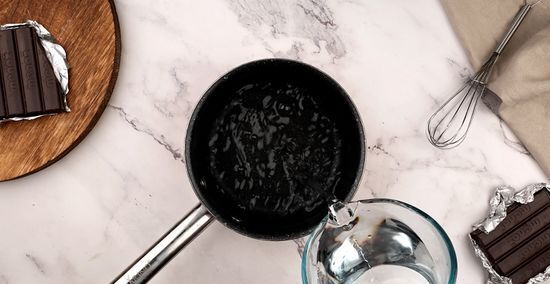
Fill your bottom pot part-way with water. You will need about two inches (5.08 centimeters) of water. Double boilers heat items with steam, not hot water, so the bottom of your upper pot (or bowl if you are using a homemade double boiler) should not be touching any water that you add into the large pot. You may need to add more water or pour some water out in order to get the right amount. Consider having some extra water nearby. The water level in your double boiler will decrease the longer you cook. You can prevent the water level from going too low and scorching your bottom pot by having a cup of water nearby. When the water level gets too low, refill the bottom pot with more water.
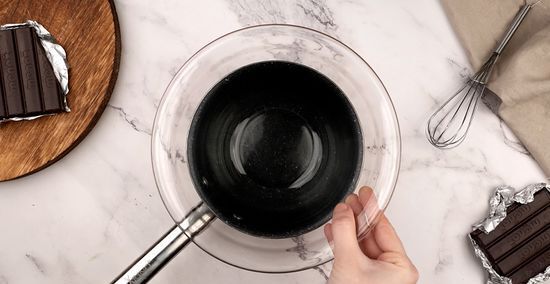
Place your upper pot or bowl on top of the bottom pot. The upper container should fit snugly over the bottom one. If bottom is touching the water, you have added too much water and will need to pour some out. The amount of water will vary depending on what double boiler you are using, but you should have about two inches of water. This will ensure that you have enough water (and thus steam) to last through most of your recipe or project.
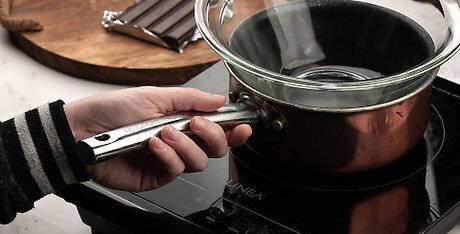
Place the entire assembly on the stove. The water will make it heavy, so make sure that you are using both hands to carry it.
Using the Double Boiler
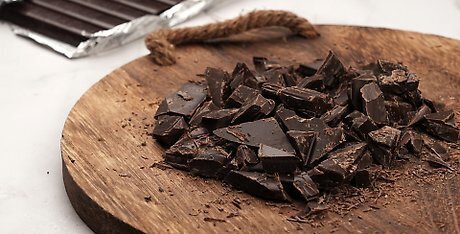
Cut the items you are heating into smaller chunks. Because double boilers generate so little heat, you will most likely need to cut whatever you are heating into smaller pieces. This is to speed up the cooking/heating process. If the items you are heating already come in smaller chunks, you will not need to cut them up. Examples of smaller items include: chocolate chips, melting chocolate disks, shaved soap, and wax pellets.
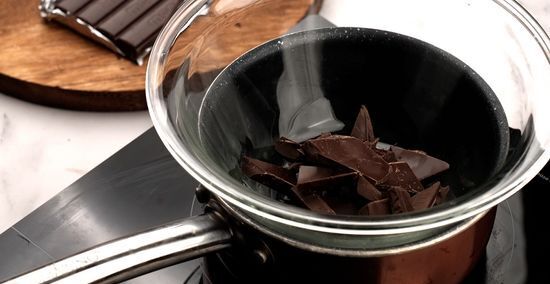
Place the items you are heating in the upper pot or bowl. Try to spread the items out evenly across the bottom so that everything gets the same amount of heat.

Turn on the stove and start heating the water. You want the water in your large pot to simmer, not boil, unless the recipe or project instructs otherwise.

Stir the items as they begin to melt. You can use a spatula, whisk, or wooden spoon. By stirring the contents, you are making sure that everything gets heated evenly. If you do not do this, some parts may end up undercooked while others might end up getting scorched or burnt.
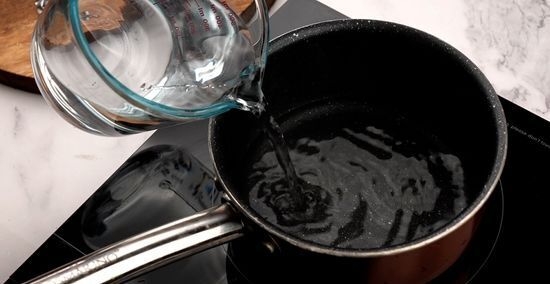
Add more water as needed. If the water level in your large pot is less than one inch (2.54 centimeters) at any point, you will need to add more water. This will allow the water to continue turning into steam and heating your items. Simply lift the upper pot or bowl off your large pot and add some water until you have about two or three inches (5.08 to 7.62 centimeters), and set the upper pot or bowl back down.
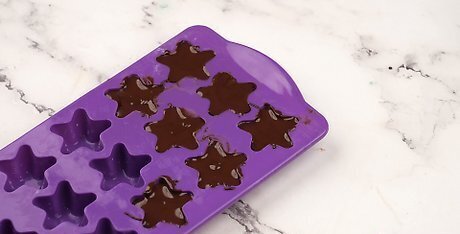
Transfer the items to a container or mold. Once the items have reached the desired consistency, remove the upper pot and pour the contents to a container or mold. If you have made your own double boiler, your upper container may not have a handle; be sure to use a glove or potholder to protect your hand from getting burned.
Heating Specific Items in a Double Boiler
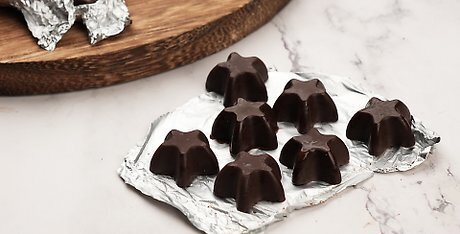
Use a double boiler to make specific recipes and craft items. Most items will require you to simmer the water, and keep the pot on the stove. Other items will require you to keep the water boiling. Some recipes or projects might instruct you to remove the pot from the stove once the water in the big pot starts to boil. This section will give you more specific instructions on how to heat more common items in a double boiler, including chocolate, soap, wax, and sauces.

Melt chocolate for dipping, drizzling, or candy-making using a double boiler. To melt chocolate in a double boiler, you will need to use low heat and a rubber spatula, and stir frequently. If your chocolate does not come in chip or pellet form, you will need to break, crush, or grate it into smaller pieces. This will help it melt faster. Do not let any water to come in contact with the melting chocolate. Water will cause the chocolate to stiffen or turn grainy. If this does happen, ½ to 1 teaspoon of shortening per ounce of chocolate will remedy the problem. To prevent dark chocolate from scorching, do not let the chocolate's temperature go over 115°F (46°C). To prevent milk chocolate and white chocolate from scorching, do not let the temperature go over 110°F (43°C).
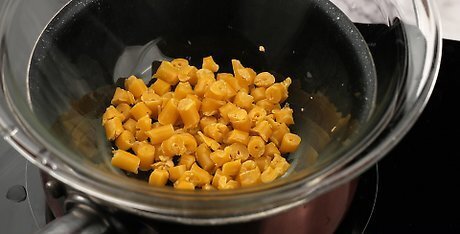
Use a double boiler to melt wax for candles. Fill the bottom pot with one to two inches of water and place a cookie cutter into it. Then, put some wax pellets, chunks, or flakes into a pouring pot used for candle making, and place that on top of the cookie cutter. You will not need the upper pot or bowl. Set the stove to medium-low and bring the water to a simmer. If your wax does not come in pellets, chunks, or flakes, you will need to cut the block into smaller pieces. This will make it melt faster. Once the wax has melted, you may add fragrances and dyes. Do not leave heating wax unattended. Wax takes a long time to melt, but once it reaches its "flash" point, it becomes flammable. Do not let the temperature of the heating wax go above 250°F (121°C).
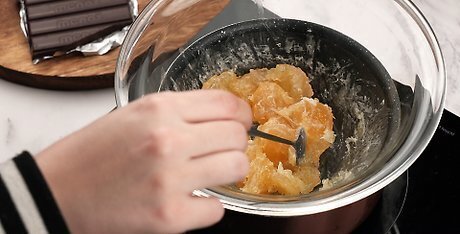
Make rebatch soap using a double boiler. Grate or shave some store-bought soap into tiny pieces and place them into the upper pot or bowl of your double boiler. You may consider adding one tablespoon of water to the soap. This is to prevent the soap from drying out while you heat it. Once the soap has melted, you may add dyes, fragrances, oils, and any other ingredients that the recipe calls for. Rebatch soap will never become fully-melted, but have the consistency of oatmeal instead. It will reach this consistency after about 20 minutes.
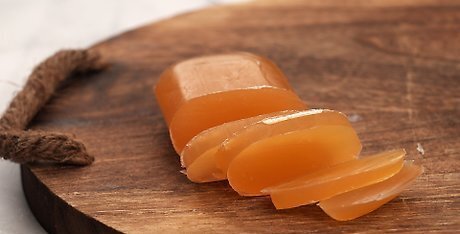
Use a double boiler to make melt-and-pour soap. Cut the soap base you will be using into chunks. If the soap base has grooves or lines, use them as guidelines when you cut. Place the chunks into the upper pot or bowl of your double-boiler. Once the soap has melted, you may add dyes, fragrances, oils, anything else that the recipe requires. Consider working with two-pound blocks. Batches of this size are the easiest to work with. Set your stove's heat to medium-low or medium. Be careful not to heat your soap too quickly.



















Comments
0 comment